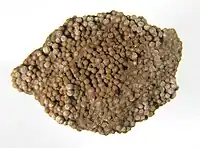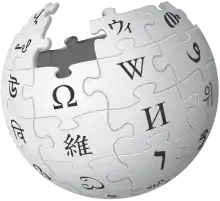oolith
See also: Oolith
English
WOTD – 31 May 2021
Etymology


A piece of oolite, occasionally known as oolith (sense 2), from Braunschweig, Lower Saxony, Germany. Oolite is a type of rock composed of ooliths (sense 1) or ooids.
Borrowed from Late Latin oolithus; the Latin word was coined by the German doctor and mineralogist Franz Ernst Brückmann (1697–1753) as a translation of German Rogenstein (“oolite”) (Rogen (“fish roe”) + Stein (“stone”)).[1] Oolithus is derived from Ancient Greek ᾠόν (ōión, “egg; seed”) (possibly ultimately from Proto-Indo-European *h₂ew- (“to clothe oneself, dress; to be dressed”), in the sense of a bird being clothed in feathers) + λῐ́θος (líthos, “a stone; stone as a substance”) (see further at that entry),[2] analysable as oo- + -lith.
Pronunciation
- (Received Pronunciation) IPA(key): /ˈəʊəlɪθ/
Audio (UK) (file) - (General American) IPA(key): /ˈoʊəˌlɪθ/
- Hyphenation: oo‧lith
Noun
oolith (plural ooliths)
Related terms
- oolite
- oolithic
- oolitic
- oolitiferous (obsolete)
References
- Francisci Ernesti Brückmanni [i.e., Franz Ernst Brückmann] (1721) Specimen Physicum Exhibens Historiam Naturalem Oolithi seu Ovariorum Piscium & Concharum in Saxa Mutatorum, Helmstedt, Lower Saxony: […] Salomonis Schnorrii [Salomon Schnorr], →OCLC.
- “oolith, n.”, in OED Online
 , Oxford, Oxfordshire: Oxford University Press, December 2020; “oolith, n.”, in Lexico, Dictionary.com; Oxford University Press, 2019–2022.
, Oxford, Oxfordshire: Oxford University Press, December 2020; “oolith, n.”, in Lexico, Dictionary.com; Oxford University Press, 2019–2022.
Further reading
 ooid on Wikipedia.Wikipedia
ooid on Wikipedia.Wikipedia - Robert L. Bates, Julia A. Jackson (1980) M. Gary, R. McAfee, Jr., and C.L. Wolf, editors, Glossary of Geology, 2nd edition, Falls Church, Va.: American Geological Institute, →ISBN.
Anagrams
This article is issued from Wiktionary. The text is licensed under Creative Commons - Attribution - Sharealike. Additional terms may apply for the media files.